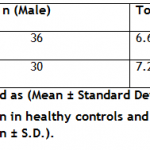Short Coummunication
Protein toxicity in Kotri Paint industry workers exposed to Phthalic Anyhydride and Trimellitic Anyhydride
Sumera Qureshi1*, Allah Bux Ghanghro2, Shaista Khan2, Ambreen Shah1
Adv. life sci., vol. 1, no. 2, pp. 73-78, Februray 2014
*Corresponding author: Sumera Qureshi (E-mails.dr582@gmail.com)
Author Affiliations
2- Institute of Biochemistry, University of Sindh, Jamshoro, Sindh – Pakistan
Abstract
Introduction
Methods
Results
Discussion
References
Abstract
Background: Protein plays a significant role in the regulation of metabolism for normal functioning in human body. SITE area, Kotri paint industry workers are at high risk of hypersensitivity, sensitization of the respiratory tract (including asthma), skin diseases and allergy. Reactive Low molecular weight organic acid anhydrides (OAAs) like trimelitic anhydride (TMA) and phthalic anhydride (PA) are extensively used in local paint industries of SITE AREA, Kotri, Sindh – Pakistan. These both anhydrides may easily bind with high molecular weight proteins by forming complex (adducts) leading to metabolic disorders among the exposed workers.
Methods: There is no study to differentiate protein status of workers compared with normal healthy group as compare in the past. In this regard, the total protein was determined in intravenous blood samples obtained from the exposed workers to TMA and PA with control group clinically by Microlab300 (Kit Method System).
Result: There is a significant decrease of protein level in paint industry workers as compared with healthy subjects, which never had exposed to TMA and PA.
Conclusion: These both allergenic organic acid anhydrides like TMA and PA may be associated for changing protein function status after forming complex (adduct) by long exposure at work. SITE Area, Kotri Paint workers may at high risk of asthma, exposed to TMA and PA.
Keywords: Protein toxicity, Phthalic Anyhydride, Trimellitic Anyhydride, Paint industry
Introduction
The globular protein like albumin as major protein synthesized in liver and transferred into blood for different metabolic functions [1,2]. Since Allergy is a common disease and its complications play major role in the exposed workers to organic acid anhydrides [3,4]. The low molecular weight Organic acid anhydrides (OAAs) are widely used chemicals in SITE Area Kotri, which can lead to toxic effects like lungs problems, allergy and sensitization among exposed workers reported in many cases earlier [5,6]. The hazardous acid anhydrides might cause health issues like occupational hypersensitivity, asthma, skin irritation infection of hands and feet to exposed workers [7-10]. Contact dermatitis was also commonly found in workers population with more exposure makes them more attractive for studies of allergens [11].
Different OAAs have certain risk factors, and the key risk leading to asthma. As in case of TMA, may have caused by the dust powder shows effects of rhinitis and conjunctivitis among workers. Eye irritation, nose blockage, cough, sneezing and asthma are commonly symptoms induced by PA and TMA [12-14]. Even special animal models were developed to investigate the inhalation model and different mechanisms of diseases caused by OAAs [6,15]. Almost all of the OAAs may have certain hyper-sensitivness to their reactivity with different protein like serum albumin (SA) and hemoglobin (Hb) to form conjugates (adducts) depending on their electrophilic activity [16-19].
Methods
The study includes 36 blood serum samples of paint workers and 30 samples from control group (aged 20-60 yrs for both groups). These workers were exposed to TMA and PA mainly by vapors inhalation and skin contact during work. All of the paint industry workers had been exposed for about 20 years as mentioned in Questionnaire taken by workers. The clinical data on paint industry workers of SITE area, Kotri workers and healthy groups are shown in table-1.
Sample Collection
This study was conducted from November 2013 up to December 2013.The SITE Area,Kotri industry workers gave consent for giving their samples by their own free will and recorded in confidential files. The intravenous blood samples (10ml) were collected and made to clot by Physician. After this serum was separated and centrifuged at about 4000 r.m.p for about 25 minutes. Finally serum was collected and stored at 40◦C prior for total protein analysis.
Sample preparation for serum samples
All reagents are of high analytical grade of Merck (Germany). It was prepared by adding 1000µl of total protein reagent (Merck) in separate tube as blank and 20µl of standard in other test tube. Serum sample (20µl) was also taken in separate test tube and run on Microlab300 accordingly. The absorbance against reagent blank was noted.
Results
Total protein was found significantly lower in case of workers as compared to control (normal) group (as shown in table-2). This result suggests that protein in the serum blood of workers may be the cause of direct toxicity of various diseases. Since TMA and PA are harmful compounds that may cause severe health hazards and problems to paint industry workers in SITE area, Kotri, Sindh.
Discussion
Ehrenberg has firstly suggested the adduct (complex) between hazardous compounds OAAs and proteins as biomarkers of exposed industry workers [20]. TMA and PA are two highly allergenic compounds (causing asthma etc.) commonly used in most of the industries [21]. Previously lots of work has been done on analysis of adducts in plasma for serum albumin and Hemoglobin proteins [22,23]. It has been proved that adducts are stable in humans with a half-life of about 20 days with long exposure to OAAs [24,25]. However, in this study of total protein gives information about the amount of metabolic protein in workers rather than the actual uptake of OAAs-protein adducts by complicated and expensive methods for low levels. It was important to compare the total plasma protein with control (normal) group for variation. In the light of findings of this study, it is understood that decreasing total protein in most of paint workers and this parameter could be used as biomarker. It is essential to reduce/hazardous risk posed by harmful chemicals used in the local industry. The both of allergenic OAAs like TMA and PA may have strong association with total plasma protein as biomarker for studies.
Acknowledgement:
This research work was supported financially by Higher Education Commission (HEC), Islamabad. Special thanks to Dr. Muhammad Faisal Qureshi from District Govt: Hospital Qasimabad, Hyderabad for the collection of blood samples.
Table-1: Clinical data of paint workers and control (normal)
Table-2: Levels of total protein in healthy controls and plastic industry workers
References
- Grundy SM, Vega GL. Role of apolipoprotein levels in clinical practice. Archives of internal medicine, (1990); 150(8): 1579.
- Irshad M, Dubey R. Apolipoproteins and their role in different clinical conditions: An overview. Ind J Biochem Biophys, (2005); 4273-80.
- Ahlfors S, Kristiansson M, Lindh C, Jönsson B, Hansson C. Adducts between nucleophilic amino acids and hexahydrophthalic anhydride, a structure inducing both types I and IV allergy. Biomarkers, (2005); 10(5): 321-335.
- Eisen HN, Orris L, Belman S. Elicitation of delayed allergic skin reactions with haptens: the dependence of elicitation on hapten combination with protein. The Journal of experimental medicine, (1952); 95(5): 473-487.
- Venables KM. Low molecular weight chemicals, hypersensitivity, and direct toxicity: the acid anhydrides. British journal of industrial medicine, (1989); 46(4): 222-232.
- Johannesson G, Rosqvist S, Lindh C, Welinder H, Jönsson B. Serum albumins are the major site for in vivo formation of hapten‐carrier protein adducts in plasma from humans and guinea‐pigs exposed to type‐1 allergy inducing hexahydrophthalic anhydride. Clinical & Experimental Allergy, (2001); 31(7): 1021-1030.
- Tarvainen K, Jolanki R, Estlander T, Tupasela O, Pfäffli P, et al. Immunologic contact urticaria due to airborne methylhexahydrophthalic and methyltetrahydrophthalic anhydrides. Contact Dermatitis, (1995); 32(4): 204-209.
- Barker R, Van Tongeren M, Harris J, Gardiner K, Venables K, et al. Risk factors for bronchial hyperresponsiveness in workers exposed to acid anhydrides. European Respiratory Journal, (2000); 15(4): 710-715.
- Ahlfors S, Sterner O, Hansson C. Reactivity of Contact Allergenic Haptens to Amino Acid Residues in a Model Carrier Peptide, and Characterization of Formed Peptide-Hapten Adducts1. Skin Pharmacology and Physiology, (2003); 16(1): 59-68.
- Welinder H, Nielsen J, Rylander L, Ståhlbom B. A prospective study of the relationship between exposure and specific antibodies in workers exposed to organic acid anhydrides. Allergy, (2001); 56(6): 506-511.
- Maccia C, Bernstein I, Emmett E, Brooks S. In vitro demonstration of specific IgE in phthalic anhydride hypersensitivity. The American review of respiratory disease, (1976); 113(5): 701-704.
- Zeiss CR, Patterson R, Pruzansky JJ, Miller MM, Rosenberg M, et al. Trimellitic anhydride-induced airway syndromes: clinical and immunologic studies. Journal of Allergy and Clinical Immunology, (1977); 60(2): 96-103.
- Grammer LC, Harris KE, Chandler MJ, Flaherty D, Patterson R. Establishing clinical and immunologic criteria for diagnosis of occupational immunologic lung disease with phthalic anhydride and tetrachlorophthalic anhydride exposures as a model. Journal of Occupational and Environmental Medicine, (1987); 29(10): 806-811.
- Wernfors M, Nielsen J, Schütz A, Skerfving S. Phthalic anhydride-induced occupational asthma. International Archives of Allergy and Immunology, (1986); 79(1): 77-82.
- Zhang X-D, Welinder H, Jönsson BA, Skerfving S. Antibody responses of rats after immunization with organic acid anhydrides as a model of predictive testing. Scandinavian journal of work, environment & health, (1998); 24(3): 220-227.
- Rosqvist S, Nielsen J, Welinder H, Rylander L, Lindh CH, et al. Exposure-response relationships for hexahydrophthalic and methylhexahydrophthalic anhydrides with total plasma protein adducts as biomarkers. Scandinavian Journal of Work Environment and Health, (2003); 29(4): 297-303.
- Lindh C, Jönsson B. Quantification method of human hemoglobin adducts from hexahydrophthalic anhydride and methylhexahydrophthalic anhydride. Journal of Chromatography B: Biomedical Sciences and Applications, (1998); 710(1): 81-90.
- Kristiansson MH, Lindh CH, Jönsson BA. Determination of hexahydrophthalic anhydride adducts to human serum albumin. Biomarkers, (2003); 8(5): 343-359.
- Nielsen J, Welinder H, Bensryd I, Rylander L, Skerfving S. Ocular and airway symptoms related to organic acid anhydride exposure–a prospective study. Allergy, (2006); 61(6): 743-749.
- Qureshi S, Memon S, Laghari A, Ghanghro A. Metabolic total protein investigation in local industry workers exposed to acid anhydrids. Sindh Univ Res J, (2009); 4163-66.
- Malo J-L, Chan-Yeung M. Agents causing occupational asthma. Journal of Allergy and Clinical Immunology, (2009); 123(3): 545-550.
- Stamler JS, Jaraki O, Osborne J, Simon DI, Keaney J, et al. Nitric oxide circulates in mammalian plasma primarily as an S-nitroso adduct of serum albumin. Proceedings of the National Academy of Sciences, (1992); 89(16): 7674-7677.
- McGill MR, Lebofsky M, Norris H-RK, Slawson MH, Bajt ML, et al. Plasma and liver acetaminophen-protein adduct levels in mice after acetaminophen treatment: Dose–response, mechanisms, and clinical implications. Toxicology and applied pharmacology, (2013); 269(3): 240-249.
- Hori K, Miyamoto Si, Yukawa Y, Muto M, Chiba T, et al. Stability of acetaldehyde-derived DNA adduct in vitro. Biochemical and biophysical research communications, (2012); 423(4): 642-646.
- Rosqvist S, Johannesson G, Lindh CH, Jönsson B. Quantification of protein adducts of hexahydrophthalic anhydride and methylhexahydrophthalic anhydride in human plasma. Journal of Environmental Monitoring, (2000); 2(2): 155-159.




